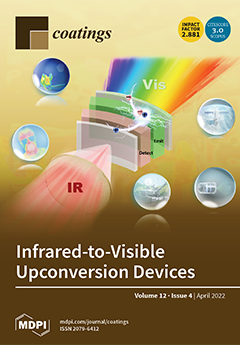A good solar selective absorber (SSA) used in building applications must have good color brightness rendering, an excellent photo–thermal conversion efficiency (PTCE) and a long life. The optical thin film design plays an important role before the coating of the optical thin films.
[...] Read more.
A good solar selective absorber (SSA) used in building applications must have good color brightness rendering, an excellent photo–thermal conversion efficiency (PTCE) and a long life. The optical thin film design plays an important role before the coating of the optical thin films. In this study, for fabricating a good colored SSA (CSSA), the optical properties and color distribution of Al
2O
3/Ti/Al
2O
3 SSA were calculated to obtain the best design. It was found that the color distribution of Al
2O
3/Ti/Al
2O
3 SSA with a PTCE in excess of 90% was wide and included all colors, such as red, orange, yellow, green, blue, purple and white. Five colored Al
2O
3/Ti/Al
2O
3 solar selective absorbers were designed and fabricated and their performances were analyzed. The best PTCE of a fabricated sample and its thermal emittance efficiency were 93.2% and 7.1%, respectively. The peak values of the measured optical reflectance in the visible region for the five fabricated CSSAs were all greater than 10%. Their lifetime could be very long because the temperature difference between thermal stability of more than 450 °C and the working temperature of less than 150 °C was up to 300 °C. After annealing at 550 °C, the Al
2O
3–Ti system formed a compound structure of AlTiO
5. The Al
2O
3/Ti/Al
2O
3 film performances, including the optical properties in the wavelength range of 0.25 to 25 μm, structure, morphology, adhesion, cross-sectional images, AFM image, PTCE, thermal emittance efficiency and thermal stability, were measured and analyzed in detail, and met the characteristic requirements of colored solar absorber films.
Full article





